Black spots on a fish’s skin is a immune system’s reaction against digenetic parasitic infection. So several small, dark brown or black markings appearing on the fish’s skin, scales, fins, and tails.
These distinctive dark patterns can manifest across various fish species, spanning from freshwater to saltwater environments.
This response leads to reduced growth, physical abnormalities, and increased mortality rates among freshwater fish populations.
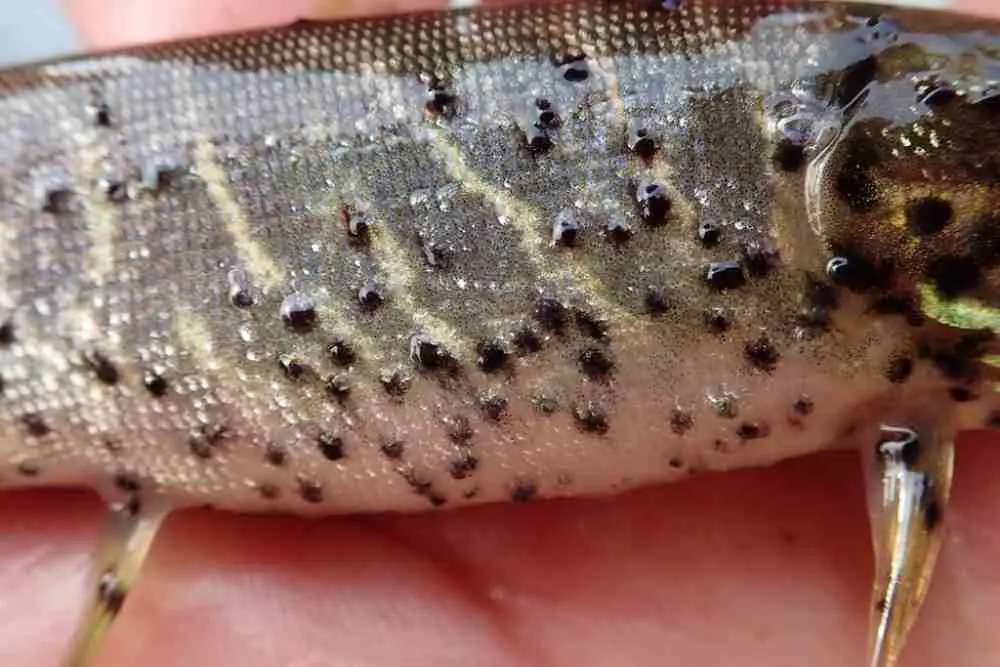
What is Black Spot on Fish and How It’s Named?
The parasite that causes the infection is a fluke dominant parasite species. The visible spots are particularly the metacercariae (larval) stages of digenetic trematodes.
But why is the disease called black spot disease?
Parasitic cysts create sporadic black spots on fish skin, so the disease named black spot disease was nicknamed after these symptoms.
The disease is known as diplopstomiasis or black spot disease of fish.
Causes of Black Spot on Fish
The disease is thought to be the consequence of a number of factors, including parasite, poor water quality, stress, and injuries to the fish’s skin.
Trematode (parasitic digenean) metacercariae may be to blame for a visually noticeable disease in fish called black spot disease.
More than 30 parasitic species causing similar symptoms have been identified in scientific research. Parasite such as Uvulifer spp., Neascus spp., Black grub caused black spots on fish.
- Neascus Genus Species: It is caused by flatworm larvae of the genus Neascus. They appear as black spots on the skin, fins, and flesh of freshwater fish. These parasites are tiny, causing dark coloration (pigmentation) resembling black pepper to be sprinkled onto fins or flesh (fillets) of fish.
- Posthodiplostomum spp: It is caused by the parasites of trematoda Posthodiplostomum cuticola, the black dot disease is to causes in fish by the metacercariae. The parasites attach to the skin and gills of the fish and feed on their blood. This can lead to tissue damage and secondary infections, which can cause the fish to die.
- Crassiphiala spp: The monotypic genus Crassiphiala of the subfamily Crassiphialinae is responsible for black spot on specific fish species. Crassiphiala bulboglossa, which parasitizes the bird kingfishers. The metacercaria stage of Crassiphiala encysts on fish (serve as intermediate host) and cause of black spot disease.
- Uvulifer ambloplitis: The larval trematode parasite Uvulifera ambilobus infects freshwater fish and causes a dark pigment to be generated after metacercariae have been made.
- Habitat degradation: Habitat degradation accompanying agricultural and urban development is associated with increased incidence of black spot in a variety of fish species. The disease is caused by a parasite that infects the fish’s skin, causing black spots to form.
- Contaminated water: The parasite is believed to be spread by contaminated water, and the increased incidence of black spot is likely due to the increased levels of pollution in waterways near agricultural and urban areas.
Geographical Distribution of Black Spot Disease
The geographical distribution of black spot disease can be found in freshwater bodies around the world, but it tends to be more prevalent in certain regions with specific environmental conditions.
The prevalence of black spot disease can vary from one location to another. It often depends on factors such as water temperature, water quality, the presence of suitable intermediate hosts (snails), and the specific fish species in a given area.
Here are some key points about the geographical distribution of black spot disease:
- Freshwater Environments: This disease primarily affects fish in freshwater environments, including rivers, lakes, ponds, and streams. Saltwater or marine fish are generally not susceptible to black spot disease.
- Temperate Regions: Black spot disease is more commonly observed in temperate regions, where snail populations, which serve as intermediate hosts for the Neascus parasite, are abundant. The disease is less prevalent in tropical regions.
- North America: Black spot disease is well-documented in North America, with cases reported in various states and Canadian provinces. It affects a range of freshwater fish species, including sunfish, bass, and catfish.
- Europe: Black spot disease is also found in European freshwater environments, particularly in regions where suitable snail hosts are present. Fish species like roach and perch are known to be affected.
- Asia: Black spot disease has been reported in various Asian countries with freshwater habitats. Carp and other cyprinid fish species can be affected in these regions.
- Africa: In Africa, black spot disease can be observed in freshwater bodies where suitable conditions exist. Tilapia and other indigenous fish species may be affected.
- Australia: Black spot disease is found in Australian freshwater systems as well, affecting native fish species.
Species Affected
- Fish among following families had black spot formations; Salmonidae, Catostomidae, Cyprinidae, Centrarchidae, and Percidae.
- Black spots often cause retardation and growth retardation in young fish but are observed less in larger and aged fish.
- Females species of Nile tilapia endured a greater incidence of illness than males.
Factors Influence the Prevalence of Black Spot Disease
1. Temperature
There was almost no development at 13° C and development was about twice as rapid at 24° C as at 21° C.
A study in Oregon’s West Fork Smith River stream found that infestation of juvenile salmonids caused by a neascus-type trematode (which belongs to the family Diplostomididae) during summers (17 to 24 degree Celsius temperature).
2. Aquatic Vegetation
Ecological conditions were a primary cause for flooding and the presence of parasites in lentic water bodies with various layers of vegetation in the littoral region.
The fish from flooded borrow pits frequently experienced a high percentage of P. cuticola infection in comparison with their fellow fish in borrow pits with steep banks, and its abundance was considerably higher in water reservoirs with steep banks than in the rivers.

Life Cycle of Posthodiplostomum cuticola
- The life cycle of a parasite typically includes the life of a bird, a snail, and a fish.
- The black spot larvae can develop to sexual maturity in the infected bird’s intestines. The adult worms transfer eggs with the bird’s droppings.
- When the eggs reach water, they hatch into free-swimming organisms that enter into snails for further expansion.
- The free-living larval stage known as miracidia. They enter the bodies of snails as an intermediate host.
- While their life cycle is metastasizing, it goes through several development stages and leaves the snail body.
- After leaving the snails, they burrow into the skin of fish and form a cyst. In fish, the cyst surrounded with black pigment, giving it the name of disease. If a bird consumes an afflicted fish, this cycle can be repeated.
Signs & Symptoms of Fish Black Spot Disease
Black spots spontaneously appeared on the skin and fins subject to varying degrees of severity.
–The appearance of black spots on the body of a fish is one of the main signs of black spot disease. These spots are usually black or dark brown, and they can be either small or large in size.
-Fish with black spots on the side and pectoral fins of fish.
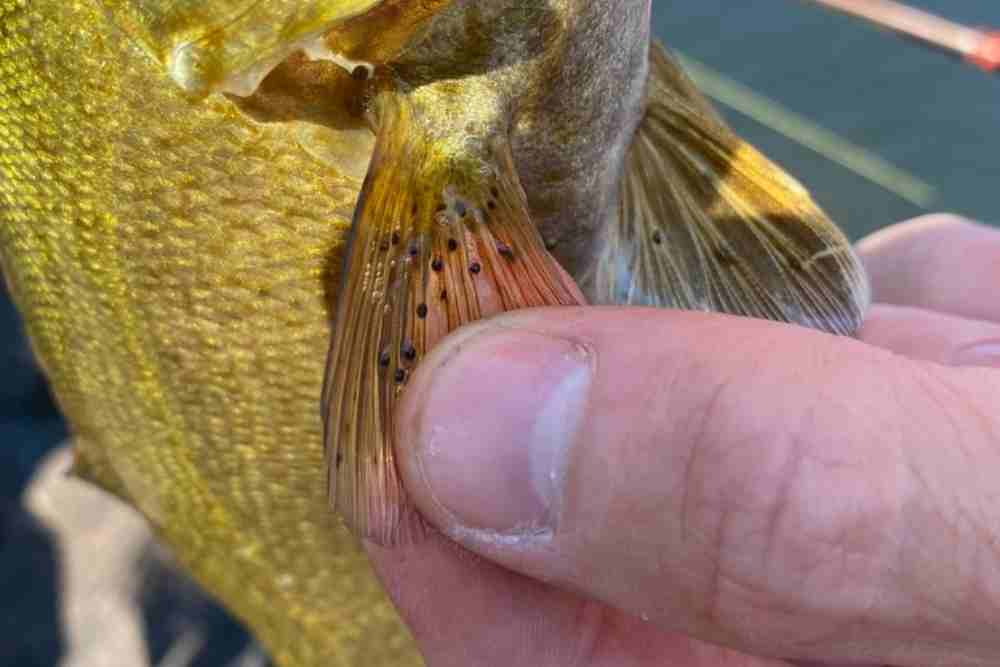
-Black spot and cyst observed in tail of fish.
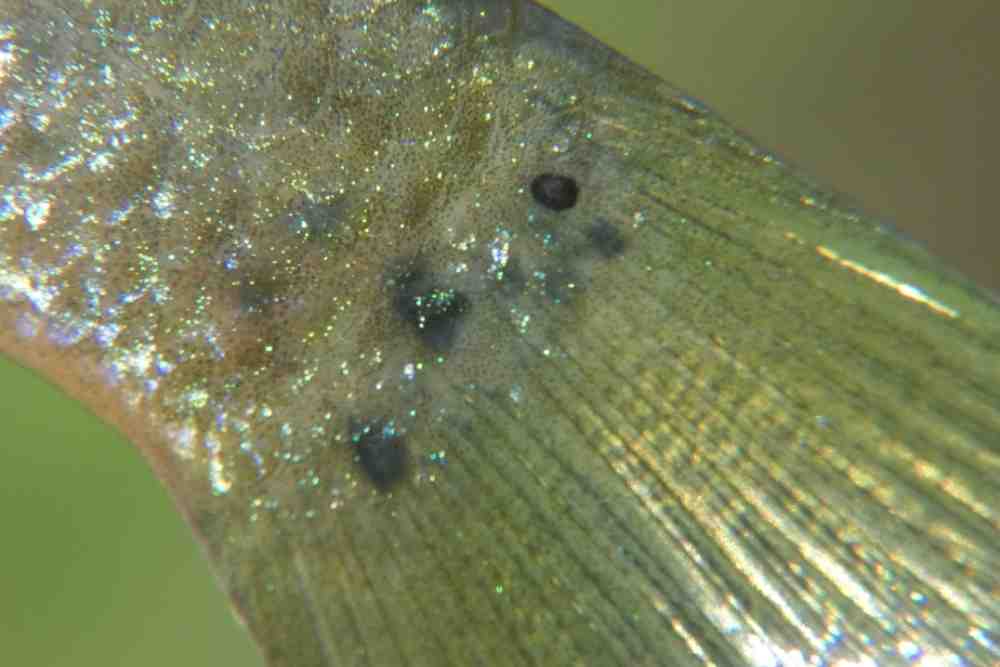
-Another sign of this disease is a change in the color of the fish’s skin. The skin may become pale or gray, and there may be areas that are covered in red lesions.
-Black spot or cyst may observed in fish muscle. Muscle atrophy, a thick fibrous capsule around the metacercaria, and black pigment melanomacrophages were observed.
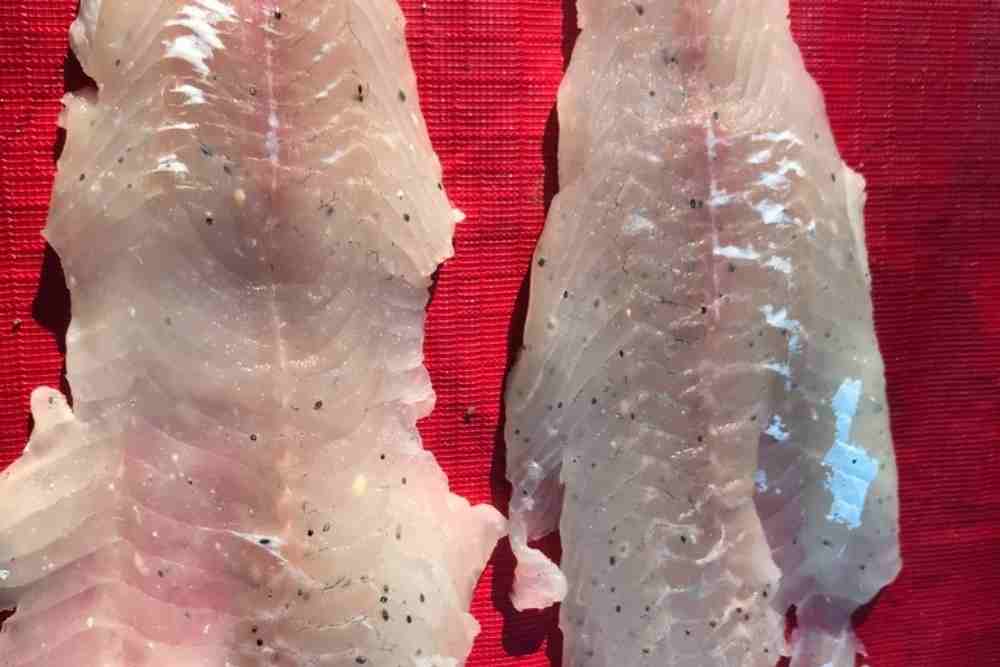
–Early signs of the disease include lethargy, loss of appetite, and skin lesions.
-Fish with black spot disease may also have trouble swimming, and they may isolate themselves from other fish in the tank.
Diagnosis of Black Spot on Fish
- Presumptive diagnosis is made by watching the pattern of small, multifocal, slightly raised black lesions within the fish skin.
- Tissue sections reveal a thick, fibrinous capsule around the encysted metacercariae with the periphery of the capsule containing numerous melanocytes.
- The diagnosis is confirmed by observing metacercariae in the cysts seen in the wet-mount preparations or histological sections.
- The histopathology data indicated the presence of Neascus spp. as the causal (aetiological agent) agent of black spot disease.
- During molecular and morphological examination of adult and larval Crassiphiala bulboglossa, the discovery of smooth lineages was shown.
How To Treat Black Spot Disease in Fish
Black spot is a serious metacercarial infestation that can lead to death in fish, and it is important to take steps to prevent the spread of the disease.
1. Salt Bath
Salt has been shown to be an effective way to treat the black spot disease of fish. The salt helps to dehydrate the protozoan parasite that causes the disease.
It is important to use non-iodized salt, such as table salt or aquarium salt when treating black spot disease.
The salt should be added to the aquarium at a concentration of 1 tablespoon per gallon of water. The treatment should be continued for at least two weeks.
2. Chemical Treatment
If you have a pond, you can use formaldehyde or copper sulfate to treat the water. Methylene blue is a medication that is used to treat black dots on fish.
3. Increase Water Temperature
The simplest way is to raise the water temperature to at least 82 degrees Fahrenheit. This will help kill the parasites.
How To Prevent Black Spot on Fish
One of the biggest threats to fish populations is black spot disease. This disease can be deadly, and it’s important to take steps to prevent it from spreading.
There are a few things you can do to keep your fish healthy and protect them from black spot disease.
- The first step in treating the black spot disease of fish is to remove the infected fish from the tank and isolate them in a quarantine tank. The quarantine tank should have clean water and be treated with a medication that is effective against black spot disease.
- The most important thing you can do is to provide good water quality. Make sure your tank is properly filtered and that the water is clean and well-oxygenated.
- You should also test the water regularly and make sure the pH level and other parameters are within the recommended range.
- You can also help protect your fish by keeping them healthy and free of parasites. Regularly check your fish for signs of infection or parasites, and treat any infections promptly.
- You should also quarantine new fish before adding them to your tank, in order to prevent the spread of disease.
Black Spots in Fish Tank
Black Spot on Betta Fish
The appearance of black spots on a betta fish can be alarming, but in most cases, they are not a sign of anything serious.
In fact, many bettas develop these spots as they age. The black spots may be located on the body, fins, or gills of the fish and they can vary in size.
If the black spots are simply due to aging and there are no other symptoms present, there is usually no need for treatment.
Black Spot on Parrot Fish
The most common ailment that plagues parrot fish is black spots. These black spots are caused by a parasite and can be treated with medication, but they often return. If the black spots are left untreated, they can spread and eventually kill the fish.
Black Spots on Cichlids
If you take a look at your average cichlid, you will notice that they have a black spot on each of their pelvic fins.
This is actually quite common in cichlids and it is not something to be concerned about. In fact, the black spot on the pelvic fin is there for a reason.
Frequently Asked Questions (FAQs)
Is it safe to eat black spot diseased fish?
The diseased fish is safe to eat, if the fish is properly cooked, the parasites will be killed and the fillet will be safe to eat.
Does the infection harm to fish?
While this may be alarming at first, it’s actually quite common and generally harmless. In fact, there are many different types of freshwater fish that can develop these black spots.
Will the infection transfer to the man if the fish is eaten?
No, the black spot infection will not transfer to the man if the fish is eaten. The black spot infection is a parasite that can only infect fish, and cannot infect humans.
If a person were to eat a fish with the black spot infection, they would not be infected with the parasite.
References
- Kurochkin, I. V., & Biserova, L. I. (1996). The etiology and diagnosis of” black spot disease” of fish. Parazitologiia, 30(2), 117-125.
- Achatz, T. J., Pulis, E. E., Fecchio, A., Schlosser, I. J., & Tkach, V. V. (2019). Phylogenetic relationships, expanded diversity and distribution of Crassiphiala spp.(Digenea, Diplostomidae), agents of black spot disease in fish. Parasitology Research, 118(10), 2781-2787.
- Harrison, E. J., & Hadley, W. F. (1982). Possible Effects of Black‐Spot Disease on Northern Pike. Transactions of the American Fisheries Society, 111(1), 106-109.
- Teixeira-de Mello, F., & Eguren, G. (2008). Prevalence and intensity of black-spot disease in fish community from a subtropical stream (Santa Lucia river basin, Uruguay). limnetica, 27(2), 251-258.
- Steedman, R. J. (1991). Occurrence and environmental correlates of black spot disease in stream fishes near Toronto, Ontario. Transactions of the American Fisheries Society, 120(4), 494-499.
- Hoffman, G. L., & Putz, R. E. (1965). The black-spot (Uvulifer ambloplitis: Trematoda: Strigeoidea) of centrarchid fishes. Transactions of the American Fisheries Society, 94(2), 143-151.
- Berra, T. M., & Au, R. J. (1978). Incidence of black spot disease in fishes in Cedar Fork Creek, Ohio.
- Hockett, C. T., & Mundahl, N. D. (1989). Effects of black spot disease on thermal tolerances and condition factors of three cyprinid fishes. Journal of Freshwater Ecology, 5(1), 67-72.
- Wanja, D. W., Mbuthia, P. G., Waruiru, R. M., Bebora, L. C., & Ngowi, H. A. (2020). Natural concurrent infections with Black Spot Disease and multiple bacteriosis in farmed Nile tilapia in Central Kenya. Veterinary Medicine International, 2020.
- Cairns, M. A., Ebersole, J. L., Baker, J. P., Wigington Jr, P. J., Lavigne, H. R., & Davis, S. M. (2005). Influence of summer stream temperatures on black spot infestation of juvenile coho salmon in the Oregon Coast Range. Transactions of the American Fisheries Society, 134(6), 1471-1479.
- Miller, M. J. (1940). Black spot in fishes. Canadian Journal of Comparative Medicine and Veterinary Science, 4(11), 303.
- Ondraekova, M., Bartosova, S., Valova, Z., Jurajda, P., & Gelnar, M. (2004). Occurrence of black-spot disease caused by metacercariae of Posthodiplostomum cuticola among juvenile fishes in water reservoirs in the Morava River basin. Acta Parasitologica, 49(3), 000-000.
- Kirse, S. C. (2010). Parasite ecology of fish with black spot disease.
- Charo-Karisa, H., Ali, S. E., Marijani, E., Ibrahim, N. A., Trinh, T. Q., Chadag, M. V., & Benzie, J. A. (2021). Genetic parameters for black spot disease (diplopstomiasis) caused by Uvulifer sp. infection in Nile tilapia (Oreochromis niloticus L.). Aquaculture, 532, 736039.
- IuV, K., & Biserova, L. I. (1996). The etiology and diagnosis of” black spot disease” of fish. Parazitologiia, 30(2), 117-125.
- Schaaf, C. J., Kelson, S. J., Nussle, S. C., & Carlson, S. M. (2017). Black spot infection in juvenile steelhead trout increases with stream temperature in northern California. Environmental biology of fishes, 100(6), 733-744.
- Lemly, A. D., & Esch, G. W. (1985). Black-spot caused by Uvulifer ambloplitis (Trematoda) among juvenile centrarchids in the Piedmont area of North Carolina. Proceedings of the Helminthological Society of Washington, 52(1), 30-35.
- Blouin, E. F., Johnson, A. D., Dunlap, D. G., & Spiegel, D. K. (1984). Prevalence of black spot (neascus pyriformis: trematoda: Diplostomatidae) of fishes in brule creek, south Dakota. Proceedings of the Helminthological Society of Washington, 51(2), 357-359.
- Kirankaya, S. G., & Ekmekcı, F. G. (2011). Frequency of black spot disease in Cobitis cf. turcica from Pınarbası Springs (Haymana, Turkey). Folia Zoologica, 60(4), 350-354.
- Dennis, M. M., Izquierdo, A., Conan, A., Johnson, K., Giardi, S., Frye, P., & Freeman, M. A. (2019). Scaphanocephalus-associated dermatitis as the basis for black spot disease in Acanthuridae of St. Kitts, West Indies. Diseases of Aquatic Organisms, 137(1), 53-63.
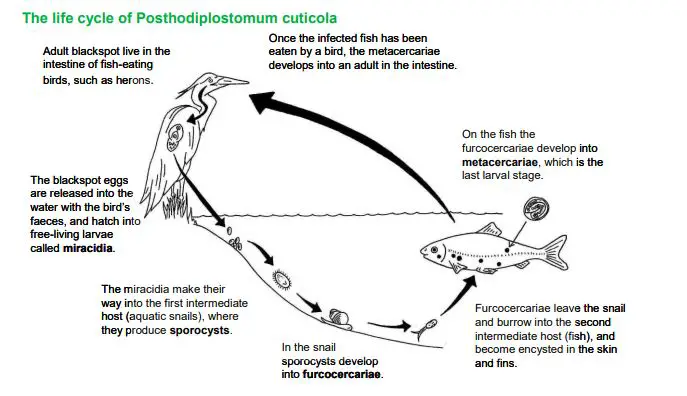
2 thoughts on “Black Spot on Fish: Causes, Symptoms & Treatment”
Comments are closed.